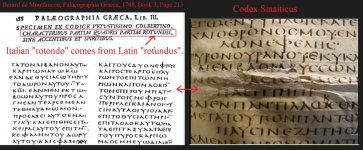TwoNoteableCorruptions
Well-known member
The use of "rotondo" is no longer a valid objection to Vitaliano's description of the Codex Sinaiticus' Greek uncial script (now technically known as "Biblical").
The Italian word "rotondo" comes from the Latin word "rotundus".
It's interesting to note the technical vocabulary used in Greek paleography at the time.
Vitaliano Donati's contemporary Bernard de Montfaucon's (who's lives overlapped by 24 years) wrote in 1708:
For his time, Vitaliano's description was accurate!
After his time, and specifically, after the Codex Sinaiticus was discovered, different names for categories of Greek Uncial script were invented and distinguished further than in Vitaliano's time.
So, when taken in context, Vitaliano's use of Italian "rotondo" was not inaccurate by the Greek paleographic standards of the day/time/age.
An interesting picture here for you Steve...
Does the Uncial script look similar to you Steven?
The Italian word "rotondo" comes from the Latin word "rotundus".
It's interesting to note the technical vocabulary used in Greek paleography at the time.
Vitaliano Donati's contemporary Bernard de Montfaucon's (who's lives overlapped by 24 years) wrote in 1708:
Berard de Montfaucon
"Palaeographia Graeca, sive, De Ortu et Progressu Literarum Graecarum"
Paris, 1708
Lib. I
Pages 113-114
"Prisca vero scriptio AEgyptiaca , qualis habetur in Codice Alexandrino, nunc Anglicano, cum aliis paris circiter aetatis omnino conſentit in exemplaribus videlicet Charactere unciali quadro et rotundo, cujusmodi [Page 114] observatur in Codicibus
ante septimum et octavum saeculum exaratis."
Berard de Montfaucon
"Greek Palaeography, or, On the Rise and Development of Greek Literature"
Paris, 1708
Book 1
Pages 113-114
“But it is a genuine ancient Egyptian script, such as is found in the Codex Alexandrinus (now English [Or: "Anglican"]) which is consistent [Or: “completely agrees”] with all the other exemplars [Or: “copies”] of about the same age, viz in the square and round uncial characters,
such as [Page 114] is observed in the Codices written before the seventh and eighth centuries.”
Here we note that the Codex Alexandrinus is described in the technical terms of the time as being written in BOTH:"Palaeographia Graeca, sive, De Ortu et Progressu Literarum Graecarum"
Paris, 1708
Lib. I
Pages 113-114
"Prisca vero scriptio AEgyptiaca , qualis habetur in Codice Alexandrino, nunc Anglicano, cum aliis paris circiter aetatis omnino conſentit in exemplaribus videlicet Charactere unciali quadro et rotundo, cujusmodi [Page 114] observatur in Codicibus
ante septimum et octavum saeculum exaratis."
Berard de Montfaucon
"Greek Palaeography, or, On the Rise and Development of Greek Literature"
Paris, 1708
Book 1
Pages 113-114
“But it is a genuine ancient Egyptian script, such as is found in the Codex Alexandrinus (now English [Or: "Anglican"]) which is consistent [Or: “completely agrees”] with all the other exemplars [Or: “copies”] of about the same age, viz in the square and round uncial characters,
such as [Page 114] is observed in the Codices written before the seventh and eighth centuries.”
"CHARACTERE UNCIALI QUANDRO ET ROTUNDO"
"SQUARE AND ROUND UNCIAL CHARACTERS"
"SQUARE AND ROUND UNCIAL CHARACTERS"
For his time, Vitaliano's description was accurate!
After his time, and specifically, after the Codex Sinaiticus was discovered, different names for categories of Greek Uncial script were invented and distinguished further than in Vitaliano's time.
So, when taken in context, Vitaliano's use of Italian "rotondo" was not inaccurate by the Greek paleographic standards of the day/time/age.
An interesting picture here for you Steve...
Does the Uncial script look similar to you Steven?
Last edited:


